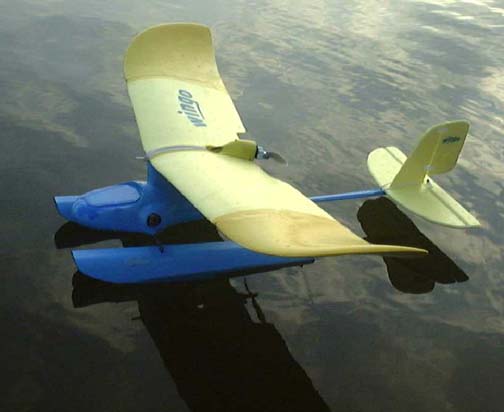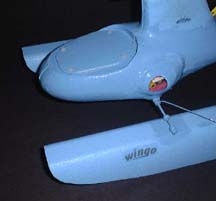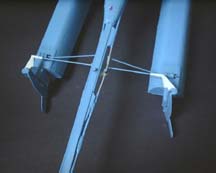

Introduction
When I read an article in Electric Flight International (April
1999) and saw the photos of the Park Fly Wingo, the seaplane version
had me hooked immediately, although I had never flown off water
before. The attraction of water is irresistible; take-off and
landing are easier than on terra firma and appear much more scale-like.
Splashes of water enhance the action and protracted 'touch-down,
slow-down and stop' type realistic landings are possible using
appropriate low throttle settings rather than full off. Touch-and-go
is also great fun. There are some pitfalls to be aware of however,
so read on..
Durability
All steel parts should be replaced or protected, especially if
there is any salt content to the water on your favourite flying
site. The snakes provided have steel inners and must be replaced
by all-plastic versions or they will soon lock up solid. Steel
struts and bracers need several coats of rust inhibitor. The servos
are peeping out of the fuselage through small openings and are
just waiting for a dose of water. Small spray blisters will prevent
this. Mine have plastic
windows which also allow inspection and maintenance if water does
gain access. Some mastic behind the servos is also a good idea,
as water might approach them from the inside (we hope not!).
 Radio
and speed controller had better be in a plastic bag and also
Radio
and speed controller had better be in a plastic bag and also
pushed well back and up in the fuselage, which should be watertight
but may not be 100%. The cockpit area (and the pilot) should be
sacrificed and replaced by a nice watertight hatch screwed down
onto a rubber seal.
Water Rudders
The addition of these will add considerably to the fun and
ease of manoeverability on the water (see later). I introduced
a break in the outer of the main rudder snake of about 2 inches
and attached a bellcrank to the fuselage boom at this point. The
snake inner drives the bellcrank using an E/Z connector. A plastic
crossmember of steel reinforced snake inner, is attached to the
bellcrank with another E/Z connector and drives each water rudder
with standard clevis and horn fittings. The water rudders (using
all-plastic hinges!) draw one inch more than the floats and extend
aft by 2 inches and also forward of the hinge line by another
1 inch to give some degree of balance to reduce side loads. (On
a full size seaplane the water rudders would retract , as landing
with them down in a cross-wind could rip them off). Shape the
rudder L.E. to discourage loose weeds from attaching themselves.

On the water
Access to a disabled model appears to bother a lot of potential
flyers and recourse to rescue boats is sometimes mentioned. Potential
troubles are mostly avoidable:
1. Running out of power. Solution: The model will drift back to
you in the breeze, unless totally flat calm (<1 knot).
2. Model drifts offshore. Solution: Avoid offshore breezes or
stick to ponds with access all round.
3. Stuck in weed! Solution: Avoid weed or get your boat!
Wingo has some special habits. First and foremost, being a Park
Fly, it will not like too much breeze; no more than 6 knots I
have found. (7 mph or top end of Force 2). It might be happy to
fly on more, but on the water the breeze takes over and can flip
it onto one wing tip or even pitchpole it. This is very undignified,
although Wingo will survive because it floats upside down on
the buoyancy of the wing leading edge with the vulnerable motor
well clear of the water due to its pusher position. This is where
the watertight hatch is tested, because it is now half under water!
It should then be blown back to you, safe but undignified.
Maneuverability on the water is important, because you want to be able to taxi around in a realistic manner and especially back to you after the flight (all part of the fun). Here you may be disappointed without water rudders. Wingo tends to weathercock and when you ask it to make a 180 degree turn downwind, it may turn 90 degrees only and then return to its original upwind course. You are no longer in charge. Water rudders will cure all this.